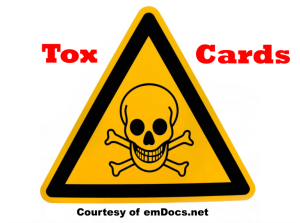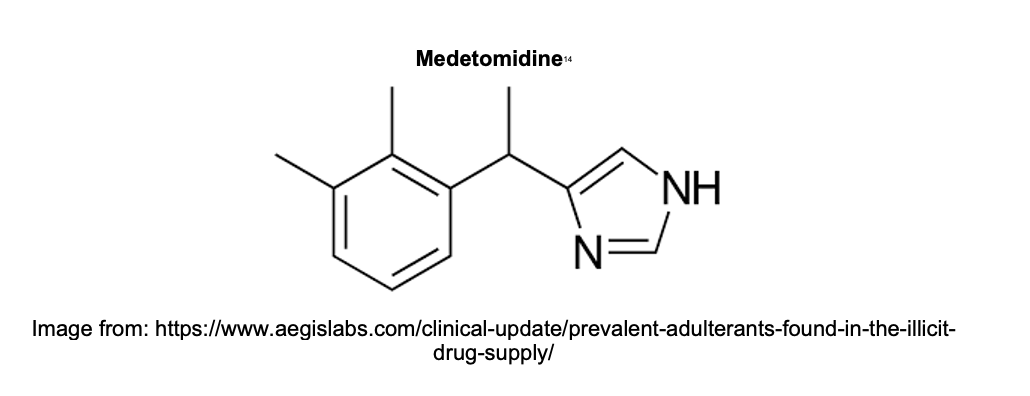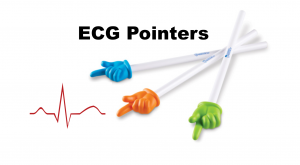Authors: Divya Krishna, MD (Emergency Medicine Resident, Penn Medicine) Sean Schlosser, MD (Emergency Medicine and Addiction Medicine faculty, Penn Medicine)// Tony Spadaro MD, (Fellow in Medical Toxicology and Addiction Medicine, Rutgers NJMS); Alex Koyfman, MD (@EMHighAK); Brit Long, MD (@long_brit)

Case:
A 32-year-old male is brought into the Emergency Department (ED) by emergency medical services for suspected opioid withdrawal. He was found to have some empty bags of white powder that he says is fentanyl. The patient says he has not used any substances for about 10 -12 hours. On arrival to the ED, he is very restless with intractable vomiting, sinus tachycardia (HR 150), and hypertension (BP 220/124). His pupils are dilated and he is diaphoretic, tachypneic, tremulous, and hiccuping. The patient reports snorting one bundle (14 bags) of fentanyl daily and is now feeling “dope sick,” but this feels different from his prior opioid withdrawal. He denies any other substance use.
Questions:
What is medetomidine?
How do medetomidine overdose and withdrawal present?
How do we treat medetomidine overdose and withdrawal?
Background:
Medetomidine is an intravenous (IV) alpha-2 agonist commonly used as a sedative/analgesic in veterinary medicine.1,2 It is a racemic mixture of dexmedetomidine (active component) and its isomer, levomedetomidine (inactive component).1 It is known to cause hypotension and bradycardia in animals; it has not been studied for use in humans.2 Dexmedetomidine by itself is used in humans in the form of an IV drip (Brand Name: Precedex), typically for sedation in the intensive care unit (ICU) setting.3

Medetomidine is a centrally and peripherally acting alpha-2 agonist.4 It is over 100 times more potent than xylazine, another alpha-2 agonist that was previously found as a common adulterant in the fentanyl supply.2,4 Medetomidine is being more commonly found in the illicit fentanyl supply in some regions, resulting in longer sedation, bradycardia, and hypotension with overdoses and a more severe and potentially deadly withdrawal syndrome.2,4 It is not known to be associated with the wounds that are typically seen with xylazine use.2,4 There has been a rapid spread and increase of medetomidine across the United States. In Philadelphia, it is found in 89% of the total tested fentanyl supply as of June 2025.5
Clinical Presentation and Diagnosis:
Medetomidine overdose and withdrawal are clinical diagnoses as there is no rapid test in the ED for detecting medetomidine.6 Medetomidine overdose presents similarly to opioid overdose with decreased responsiveness and pinpoint pupils, but with more pronounced sedation, hypotension, and bradycardia.8
Medetomidine withdrawal syndrome typically presents with agitation that can progress to encephalopathy, vomiting, diaphoresis, tremors, severe hypertension and tachycardia.6 The Clinical Opiate Withdrawal Scale (COWS) used to assess severity of opioid withdrawal can be difficult to interpret in patients undergoing concurrent medetomidine withdrawal because of the overlapping withdrawal syndromes. Both opioid and medetomidine withdrawal cause restlessness/agitation, sweating, mydriasis, vomiting, tremor, anxiety and tachycardia; but only medetomidine withdrawal seems to consistently cause hypertension, with a unique tremor and can occur with a very quick onset.2,6,9 Those experiencing medetomidine withdrawal tend to be very tachycardic (HR > 140) and very hypertensive (systolic BP > 180) due to the sudden alpha-2 agonism deficiency.2
Management:
Overdose Management
To date, medetomidine exposures have been in the context of its contamination of illicit fentanyl.2 Therefore medetomidine overdose often co-occurs with fentanyl overdose and they must be treated simultaneously. The overdose toxidrome presents with depressed mental status, bradypnea, hypotension, and bradycardia.9 There is no clinically available reversal agent for medetomidine, so management is primarily targeted at supporting airway protection, mental status, ventilation and blood pressure. Naloxone can be used to try to reverse the opioid component of overdose but has no effect on the alpha-2 receptors.9 Naloxone can be given intranasally (2-4mg), intramuscularly (0.4-2mg), or intravenously (0.04-2mg).10
Patients who overdose on opioids with medetomidine have a prolonged sedation period that requires more careful monitoring of vitals and mentation over time.9 Hypotension may be transiently reversed with fluids or vasopressors, but may not require intervention if the patient appears stable. Patients more naive to medetomidine may require intubation and ventilation for airway protection, hypoxia, and hypercapnea.
Animal studies show that there is an effective medetomidine reversal agent – Atipamezole.11 This medication can reverse sedation, bradycardia, and bradypnea associated with high doses of medetomidine. However, it has only been tested in animals and is not approved for use in humans and could, theoretically, result in a difficult to reverse withdrawal syndrome in patients chronically exposed to medetomidine.11
Withdrawal Management
Prolonged exposure to medetomidine seems to result in tolerance and dependence. Sudden discontinuation results in a withdrawal syndrome characterized by pronounced agitation that can progress to encephalopathy, nausea, vomiting, diaphoresis, mydriasis, tremor, tachycardia, tachypnea, and severe range hypertension.2,9 Unlike opioid withdrawal, this syndrome can be fatal and required careful monitoring of vitals and COWS over time.2 Medetomidine withdrawal management requires replacement of alpha-2 tone with either dexmedetomidine or clonidine.7 Treatment with long-acting opioids (methadone 40mg PO q4hr, oxycodone ER 40mg q8hr), short-acting opioids (hydromorphone 4-8mg IV q2hr prn for COWS > 8, oxycodone IR 40mg PO), sedatives (midazolam 5mg IV, ativan 2mg IV, ketamine 0.375 mg/kg PO or 0.1-0.5 mg/kg/hr IV infusion), and antiemetics (olanzapine 10mg IV, prochlorperazine 10mg IV, ondansetron 4mg IV or PO, metoclopramide 10mg IV, trimethobenzamide 200mg IM) help facilitate oral alpha-2 agonist replacement with clonidine. While a typical clonidine dose is 0.1-0.3mg q8hr, patients experiencing medetomidine withdrawal may require higher doses with close monitoring of vitals, up to 0.2-0.5mg q1hr prn for HR > 120 and SBP > 180.2 Buprenorphine (8-16mg q8hr) is another standard medication to treat opioid withdrawal symptoms, clinicians should know when the patient last used opioids to balance the risk of buprenorphine precipitated withdrawal.12
If the concomitant opioid withdrawal is unable to be controlled and patients have difficulty tolerating oral medications due to profuse vomiting, they will require IV dexmedetomidine (0.5-1.5 ug/kg/hr) titrated to a SBP < 160.2 By first treating their opioid withdrawal with high doses of IV short-acting opioids such as hydromorphone and long acting opioids methadone (20mg IV, if QTc is not prolonged above 500ms), patients may be able to better tolerate the oral alpha-2 agents such as clonidine.2 These alpha-2 agonists help with the discomfort, tachycardia and hypertension often associated with medetomidine withdrawal. Some studies show that up to 90% of patients experiencing medetomidine withdrawal go to the ICU, though these have a small sample size and are based on cases of individuals experiencing very severe withdrawal.13 Alpha-2 agonist therapy can then be weaned, over the next 24-72 hours in the case of dexmedetomidine, or days to weeks in the case of clonidine.13 Once weaned off dexmedetomidine, patients are often able to be transferred to the floor and ultimately discharged on clonidine. If available, consider consulting addiction medicine or medical toxicology for further management of complex withdrawal. Social work or care navigators may be able to assist in connecting the patients to outpatient addiction treatments. It is important to dispense take-home naloxone to patients who are being discharged to reduce the risk of overdose in the community.
Case Follow-up:
This patient was given multiple 8mg doses of IV hydromorphone to manage short-acting opioid withdrawal, 10mg of IV olanzapine and 10mg of IV prochlorperazine to manage vomiting, followed by 40mg of PO methadone and 40mg of oxycodone for long-acting opioid withdrawal management. He was able to tolerate 3, 0.5mg doses of PO clonidine over a few hours and was given a clonidine patch. After giving IV fluids and adjunct medications – acetaminophen, ketorolac, ondansetron, PO ketamine – the patient’s tachycardia resolved with a HR in the 80’s, his BP resolved to 144/92, and he became more alert and less agitated. His COWS dropped from 22 to 5. He was subsequently admitted to the medical floor and was started on a buprenorphine microdose induction (0.4mg q6hr and ramped up until reaching 4mg q8hr) and scheduled clonidine (0.3mg q8hr) which was slowly tapered.
Clinical Pearls:
-Medetomidine is an alpha-2 agonist that can cause prolonged sedation, bradycardia and hypotension in overdoses – which requires prolonged observation and close monitoring of vitals
-Medetomidine withdrawal can result in profound tachycardia and hypertension, encephalopathy and difficult to control vomiting
-Medetomidine withdrawal can be treated with several doses of long and short acting opioid agonists in addition to alpha-2 agonists such as clonidine (PO) or dexmedetomidine (IV), antiemetics and benzodiazepines
-Medetomidine adulteration in the fentanyl supply is increasing in prevalence, so it is important to know what is in the local drug supply when considering whether or not a patient may have medetomidine overdose or withdrawal
References:
- Schwarz ES, Durney P, Horn PD, et al. Notes from the Field: Detection of Medetomidine Among Patients Evaluated in Emergency Departments for Suspected Opioid Overdoses — Missouri, Colorado, and Pennsylvania, September 2020–December 2023. MMWR Morb Mortal Wkly Rep. 2024;73(50):1138–1140. doi:10.15585/mmwr.mm7350a1.
- Center for Addiction Medicine and Policy. Medetomidine. Published April 23, 2025. Accessed September 30, 2025. https://penncamp.org/medetomidine/
- Gertler R, Brown HC, Mitchell DH, et al. Dexmedetomidine: a novel sedative-analgesic agent. Anesthesiology. 2001;95(2):395–405. doi:10.1097/00000542-200108000-00023.
- Zhu DT, Palamar JJ. Responding to medetomidine: clinical and public health needs. Lancet Reg Health Am. 2025;44:101053. doi:10.1016/j.lana.2025.101053.
- Pennsylvania Groundhogs. PAG, others release statement on medetomidine scheduling. Published June 2, 2025. Accessed September 30, 2025. https://pagroundhogs.org/news/f/pag-others-release-statement-on-medetomidine-scheduling.
- Ostrowski SJ, Tamama K, Trautman WJ, Stratton DL, Lynch MJ. Notes from the Field: Severe Medetomidine Withdrawal Syndrome in Patients Using Illegally Manufactured Opioids — Pittsburgh, Pennsylvania, October 2024–March 2025. MMWR Morb Mortal Wkly Rep. 2025;74(15):269–271. doi:10.15585/mmwr.mm7415a3.
- London KS, Thomas SA, Gladden RM, et al. Severe Fentanyl Withdrawal Associated With Medetomidine Adulteration: A Multicenter Study From Philadelphia, PA. JAMA Psychiatry. 2025;82(4):345–352. doi:10.1001/jamapsychiatry.2025.0012.
- Nham A, Gladden RM, Thomas SA, et al. Overdoses Involving Medetomidine Mixed with Opioids — Chicago, Illinois, May 2024. MMWR Morb Mortal Wkly Rep. 2025;74(15):266–268. doi:10.15585/mmwr.mm7415a1.
- Centers for Disease Control and Prevention. Responding to Overdose and Withdrawal Involving Medetomidine — Updated Guidance. Published May 2025. Accessed September 30, 2025. https://www.cdc.gov/medetomidine-guidance.
- Datta P, Smith M, Patel S, et al. The Optimal Initial Dose and Route of Naloxone Administration for Successful Opioid Reversal: A Systematic Literature Review. J Med Toxicol. 2025;21(2):123–130. doi:10.1007/s13181-025-00450-0.
- Ruskoaho H, Kallio K, Tammisto T. Effects of early atipamezole reversal of medetomidine-ketamine anesthesia in mice. Acta Pharmacol Toxicol (Copenh). 1989;64(4):315–320. doi:10.1111/j.1600-0773.1989.tb01332.x.
- Kampman K, Jarvis M, American Society of Addiction Medicine (ASAM) National Practice Guideline Committee. The ASAM National Practice Guideline for the Treatment of Opioid Use Disorder: 2020 Focused Update. J Addict Med. 2020;14(2S Suppl 1):1-91. doi:10.1097/ADM.0000000000000633
- Ferri M, DeMaria A, Martin A, et al. Diagnosis and management of medetomidine withdrawal: Clinical implications of the shifting illicit opioid landscape. J Subst Abuse Treat. 2024;163:209529. doi:10.1016/j.jsat.2024.209529
- Aegis Sciences Corporation. Prevalent Adulterants Found in the Illicit Drug Supply. Aegis Labs, April 10, 2025. Accessed October 4, 2025. https://www.aegislabs.com/clinical-update/prevalent-adulterants-found-in-the-illicit-drug-supply/





